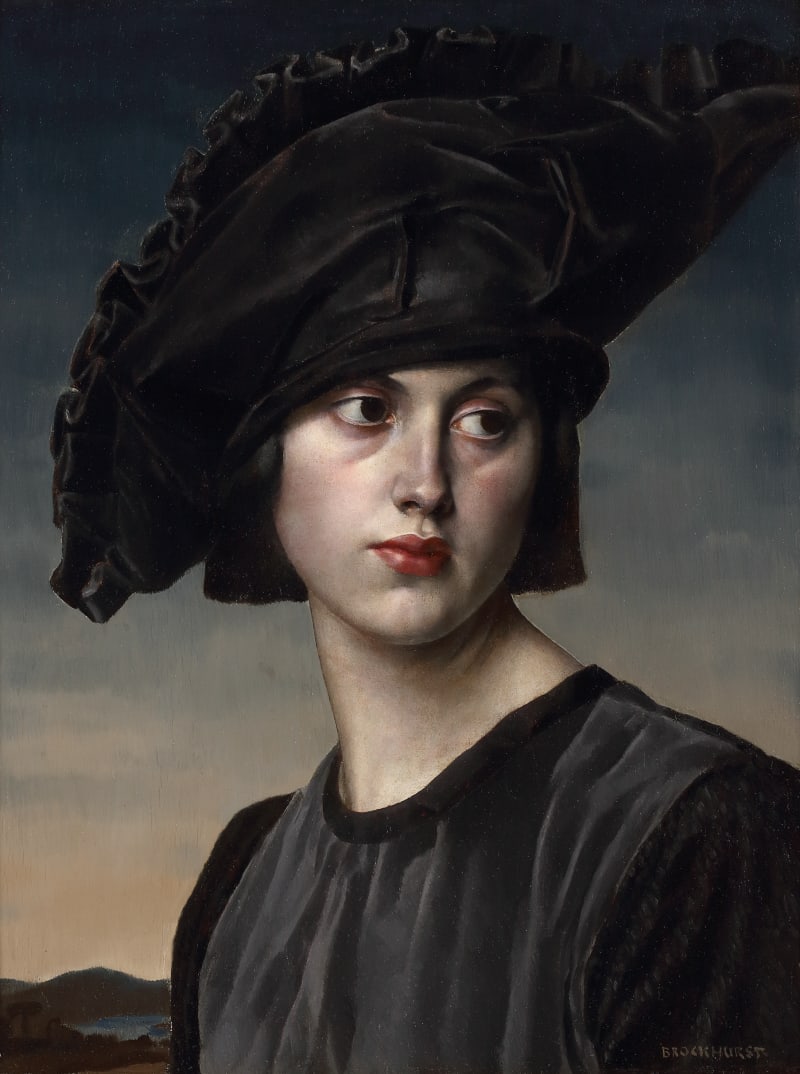Enquire
To view all current artworks for sale visit philipmould.com
For a contemporary commentator writing in British Vogue of April 1919, the power of Gerald Leslie Brockhurst’s work lay in his ability to give ‘an edge to forms which vision does not experience’.1 There can be few better illustrations of this remark than this portrait of Brockhurst’s first wife, Anaïs, set defiantly against a mountainous landscape.
Brockhurst, who was for one critic the ‘most outstanding academic draughtsman of the day’, had shown his artistic gifts from a very early age.2 The son of a coal merchant, he was aged only twelve when he enlisted at the Birmingham School of Art in 1901, where he was hailed as a ‘young Botticelli’, a remark made particularly apposite by his subsequent reverence for the works of the High Renaissance. Brockhurst never forgot his Birmingham roots, and later returned to paint the portrait of the city’s mayor, A.C.J. Wall, a wealthy...
For a contemporary commentator writing in British Vogue of April 1919, the power of Gerald Leslie Brockhurst’s work lay in his ability to give ‘an edge to forms which vision does not experience’.1 There can be few better illustrations of this remark than this portrait of Brockhurst’s first wife, Anaïs, set defiantly against a mountainous landscape.
Brockhurst, who was for one critic the ‘most outstanding academic draughtsman of the day’, had shown his artistic gifts from a very early age.2 The son of a coal merchant, he was aged only twelve when he enlisted at the Birmingham School of Art in 1901, where he was hailed as a ‘young Botticelli’, a remark made particularly apposite by his subsequent reverence for the works of the High Renaissance. Brockhurst never forgot his Birmingham roots, and later returned to paint the portrait of the city’s mayor, A.C.J. Wall, a wealthy...
To view all current artworks for sale visit philipmould.com For a contemporary commentator writing in British Vogue of April 1919, the power of Gerald Leslie Brockhurst’s work lay in his ability to give ‘an edge to forms which vision does not experience’.1 There can be few better illustrations of this remark than this portrait of Brockhurst’s first wife, Anaïs, set defiantly against a mountainous landscape. Brockhurst, who was for one critic the ‘most outstanding academic draughtsman of the day’, had shown his artistic gifts from a very early age.2 The son of a coal merchant, he was aged only twelve when he enlisted at the Birmingham School of Art in 1901, where he was hailed as a ‘young Botticelli’, a remark made particularly apposite by his subsequent reverence for the works of the High Renaissance. Brockhurst never forgot his Birmingham roots, and later returned to paint the portrait of the city’s mayor, A.C.J. Wall, a wealthy and well-known patron of the arts, who was once the owner of the present work. Six years later, in 1907, he enrolled to study at the Royal Academy Schools. His abundant talents won him many accolades, including a gold medal and a travel scholarship. The scholarship provided Brockhurst with the opportunity to go to Italy. He set out in 1913 following his graduation, passing through France en route. He was accompanied by his wife Anaïs, whom he had married in December 1911. Brockhurst had been captivated by the striking looks of this French timber merchant’s daughter, herself an artist, and she served as the subject of many of his finest early works. The journey proved a transformative experience for Brockhurst, who was captivated by the works of the artists of the Italian quattrocento, most notably Sandro Botticelli, Piero della Francesca and Leonardo da Vinci. In 1915, the pair moved to Ireland where they were introduced to the raffish figure of Augustus John and his circle. Indeed, the present work, with its wild and dramatic mountainous landscape, seems likely to have been set here. It shows, moreover, the influence of the artist’s recent time in Italy, in the clear and confident line, the historicising dress, and the Piero-esque stillness of the landscape. Despite this, the boldness of Anaïs’s pose is entirely Brockhurst’s. It has been squared up, suggesting that it may once have been intended to serve as the basis for a larger work. The ensuing years saw Brockhurst move from strength to strength. By the 1930s, he had become ‘one of the highest paid artists of all time’, painting a range of sitters that included the Duchess of Windsor and Marlene Dietrich. His gift for line translated well into etching, of which medium he became a celebrated master. By this point, however, he had also met Kathleen Woodward. Brockhurst became transfixed by this sixteen-year-old model at the Royal Academy, and she gradually replaced Anaïs as a subject in his paintings. As John had renamed his muse Dorelia, so Brockhurst renamed Kathleen Dorette. Unknown to Anaïs, however, she also became his lover. When Dorette revealed this in an interview given in 1937 – the year of Brockhurst’s election to the Royal Academy – scandal ensued and a furious and humiliated Anaïs sued for divorce. When she was eventually granted this in 1940, Brockhurst and Dorette moved to America for the rest of their lives. |




